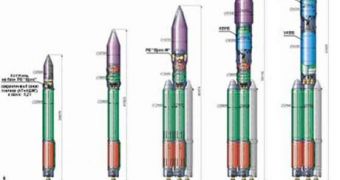The Russian space agency RosCosmos has been planning for its new family of rockets, the Angara, for many years. It sees them as the replacements for a large number of its current space vehicles, but the project has been plagued with delays for quite some time now, and progress has been slow. The Angara family was approved by the government as far back as 1995, but very few funds were actually alloted to making it a reality. Now, following the successful completion of a number of ground tests, enthusiasm is building up that members of the rocket group could launch by 2015, Space reports.
The Russians plan to use the new rockets to replace some of the oldest vehicles in their space fleet, including the Rockot, Kosmos 3M, Zenit and Proton delivery systems. All of these are currently used to send satellites in orbit, and are being employed by the market accordingly. Plans are to make the new rockets available to national and international partners. They will be able to launch both commercial and military payloads to low-Earth orbits and even geostationary ones, officials at RosCosmos say.
“Some time in the middle of the next decade, there will [be] a transitioning to the Angara system. As that evolves, we will announce further plans associated with that,” International Launch Services President Frank McKenna says. He adds that satellites will be launched around 2015 onboard Angara rockets, instead of their usual Proton delivery systems. Russian officials have also announced that all of the Angara launches, regardless of whether they are of light, medium or heavy rockets, will happen at the Plesetsk Cosmodrome, in northern Russia, some 800 kilometers away from Moscow.
The ILS representative says that the Russians will first have to demonstrate the viability of their new systems, before they can expect international partners to trust their satellites to the new rocket family, over the famous Proton vehicles. “The testing is being done well, but commercial introduction of that won't be until we're certain that everything can be done with no gaps in continuity of service for support of the commercial launch industry,” McKenna reveals.
If the new rockets manage to prove themselves worthy, they could have a bright future ahead of them, launch-wise. “Between 1996 and 2009, the early part of this year, there were 50 ILS commercial launches. We'll be up to 75 launches commercially probably in the next two or three years. I expect there will be another 25 launches after that. That's probably 100 commercial launches cumulatively for ILS. I think there will be continued growth beyond that, but it's kind of a marginal rate. I think the Ariane system and our system are very well optimized for launching five-and-a-half to six metric-ton satellites. That's why we did it and it's why it's been successful,” McKenna concludes.

 14 DAY TRIAL //
14 DAY TRIAL //